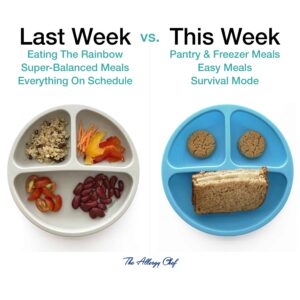I know some of you are absolutely feeling overwhelmed by the sheer amount of food you prepare on a weekly basis. If you’re newly diagnosed, and coming from a life of food conveniences, the free-from life can be a real shock to the system. Then are those who don’t even like to cook, yet it has become a sudden necessity.
No matter why you’re here, today I’ll be sharing some common struggles and solutions to help you make your free-from cooking more sustainable. I want you to be able to free up some of your time and mental bandwidth so you can rest, or get other important things done.
Whilst these suggestions won’t fix everything overnight, they’ll help you create a more sustainable workflow and in a few weeks from now, you’ll feel the pressure start to ease.
I’m Tired of Cooking All the Time
Me too friend. Me too. I’ve been where you are. When the kids were little (remember, there are four of them), there were meals where I had to cook 3 versions. Multiply that over three times a day PLUS snacks. Talk about burn out city.
The solution here is batch cooking. There’s simply no way around that. Once I started batch cooking their most loved dinners, things got better. The thing about batch cooking that people overlook is just how much time you can save.
It takes the average person 45 minutes to get dinner served. With batch cooking, you only do about an extra 5 – 10 minutes of veg prep. Now, multiply those savings over each meal you batch cook and suddenly you’re saving SO MUCH time.
In my humble opinion, batch cooking is the only way to ensure that you start to thrive.
They Won’t Eat What I Serve
If you’re dealing with a selective/picky eating stage, there are a few things you can do to work around it. First, serve meals family style, and if needed, deconstructed as well. This allows a picky eater to eat the parts they enjoy.
Second, get kids involved. The more they touch and work with food, the more likely they are to eat it. And whilst you’re at it, have them help meal plan too.
Third, remember, it takes time to learn to enjoy food. Keep talking positively about food and exposing them to foods. Just don’t force them to eat anything, as that never ends well in the long run.
Fourth, enlist the help of novelty items. It can be fun cutlery, food picks, mini cookie cutters, and so on. Sometimes changing up how we serve food can make it a lot more fun.
For more tips on making food fun for selective/picky eaters, read this article on making food fun and you can read this article on creating new food exposures.
They’re Always Hungry
This can be a real struggle, especially during growth spurts. The biggest tip I can give you is to make sure you’re creating meals that satisfy. When we combine protein and fat, we create meals that keep you fuller, longer. With each meal you’re serving, be sure to provide both.
If there are specific proteins and fats your kids enjoy, and they won’t eat others, serve what they enjoy. Not every single meal needs to include an exposure to foods they’re still learning to enjoy.
Gluten Free and Allergy Friendly Food is Too Expensive
When I look at the cost of food right now, I wonder how some people without food allergies are even making it. We all know that a loaf of gluten free bread can cost 2 – 3x what a standard loaf costs. Multiple those price increases over practically every ingredient we need in our free-from lives and it’s a recipe for near bankruptcy as of late.
The first part of the solution is to analyze your receipt. Anything over what you think is too much needs to be in question. For me, anything over $4.99 is what I ask myself about. Most likely, everything over that number is a product of convenience. Now you have to ask, do we NEED this item. If no, ditch it. If yes, COULD you make it yourself for less money?
You’ll also have to remember the cost of your time, gas, electricity to run your appliances, and so on. In our case, it’s a lot less expensive to make everything, though, we don’t really have much of a choice due to the diagnosis.
The next part of the solution is to start adding in budget friendly meals to your rotation. One of the most low cost meals is beans and rice with a side of frozen veg. It’s nutritious, and you can season it in a range of ways.
My last big tip right now is to shop in bulk and/or at outlet/discount grocery stores. You can get some great deals shopping both ways. Stores such as Costco and Grocery Outlet have helped us save hundreds each month on groceries.
For more tips on managing a budget when you’re free-from, read this article.
I Don’t Have Time for All of This Cooking
There are a few solutions that stand out if this is your current struggle. First, refer to the top of this article where I talk about batch cooking. That will save you loads of time.
Second, for those with older kids, have them make one meal a week. It’s a great skill to have, and it takes some of the pressure off of you. When my kids were old enough, each kid was in charge of dinner one night a week. Sometimes, they’d even have a team project to do all the planning, shopping, and cooking together without my help. It teaches them a much needed life skill. Bonus points if you give them a budget to work within.
Another tip: use quick/easy cooking methods such as a pressure cooker or sheet pan meals.
Totally relevant and hilarious side story. When my kids were on the younger side, they had to budget the meals for a whole day. The reward was that they got to keep any extra money leftover. One child who will remain unnamed told their siblings they all had to sleep in to skip breakfast, they were getting basic sandwiches for lunch, and beans & rice for dinner. I still laugh at the thought… he wanted to starve them to save a buck. Thankfully I stepped in and changed his plans.
This 50 Fast & Easy Free-From Dinners cookbook may be of great service to you as well.
I Don’t Know How to Cook and/or Bake
That’s OK! There are several tools available to help you. Cookbooks, online courses, and in-person courses can all teach you cooking basics. There are even some courses that are now tailored for free-from cooking. RAISE has sections on Easy Cooking Videos, How To Videos (cooking basics and more), as well as an Advanced Recipe Search with more than 85 filters so you can make what works for you.
When you’re new to cooking, don’t be afraid to make great use of canned beans, frozen vegetables, and other basics. These can help ease you into cooking, and make it less overwhelming.
Tools that I love for beginning cooks: pressure cooker and/or multi-function cooker (such as an Instant Pot), rice cooker (preferably with the steamer basket insert), and a good blender. These three tools along with a couple of pots and pans will have you cooking and loving the basics in no time.
When all else fails, remember, it’s OK to serve a collection of snacks like a charcuterie board and call it a meal. You can absolutely have a range of nutrition even when serving food that way.
For Those Who Like to Meal Plan
Be sure to go to the free downloads section of the site to download a range of free meal plans.
The RAISE Membership site has a collection of pre-made meal plans as well, and files I like to call Visual Meal Inspiration.
Kids Eat in Color Real Easy Weekdays is special product that you might LOVE. It’s a month of meal plans along with recipes, batch cooking, and more. Jennifer enlisted my help on her project, and I essentially created a clone of her plan, but all gluten free and top 9 allergy free. There are notes for oats, legumes, truly corn free, and more. It also comes with an allergy friendly pantry guide. It’s an all-in-on system for those who need that type of solution.




